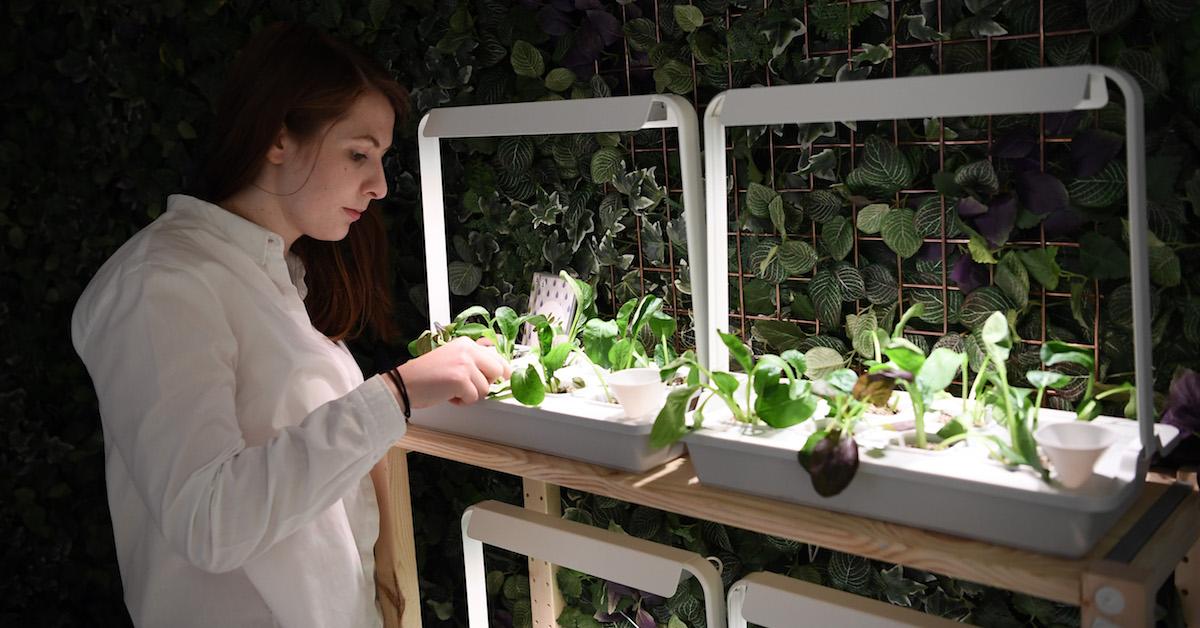How to Start a Hydroponic Garden at Home
In recent years, hydroponic gardening has gained immense popularity among gardening enthusiasts and those looking to grow their own fresh produce. This innovative and efficient method of growing plants without soil offers numerous advantages, including faster growth, higher yields, and the ability to cultivate plants in limited space. If you're interested in starting a hydroponic garden at home, you're in for an exciting and rewarding journey. This comprehensive guide will walk you through the steps to get started and help you create a thriving hydroponic garden in the comfort of your own home.

How to begin a home hydroponic garden
In recent years, hydroponic gardening has gained immense popularity among gardening enthusiasts and those looking to grow their own fresh produce. This innovative and efficient method of growing plants without soil offers numerous advantages, including faster growth, higher yields, and the ability to cultivate plants in limited space. If you're interested in starting a hydroponic garden at home, you're in for an exciting and rewarding journey. This comprehensive guide will walk you through the steps to get started and help you create a thriving hydroponic garden in the comfort of your own home.
What is Hydroponic Gardening
Before diving into the practical aspects of starting a hydroponic garden, it's essential to understand what hydroponic gardening is and how it works.
Hydroponic gardening is a method of growing plants without traditional soil. Instead of soil, hydroponic systems use nutrient-rich water to deliver essential minerals and nutrients directly to the plant roots. This allows plants to grow faster and more efficiently because they can absorb nutrients more readily. Hydroponics provides precise control over growing conditions, including temperature, humidity, and pH levels, resulting in optimal growth and healthier plants.
There are various types of hydroponic systems to choose from, including deep-water culture, nutrient film technique, aeroponics, and more. The choice of system depends on your preferences, available space, and the type of plants you want to grow.
Why Start a Hydroponic Garden at Home
There are several compelling reasons to consider starting a hydroponic garden at home:
Year-Round Growing Hydroponic gardening allows you to grow plants year-round, regardless of the weather conditions outside. This is especially beneficial if you live in an area with harsh winters or scorching summers.
Space Efficiency Hydroponic systems can be tailored to fit small spaces, making them ideal for urban dwellers or those with limited gardening space.
Faster Growth Plants grown hydroponically tend to grow faster than those in traditional soil-based gardens. This means you can enjoy your harvest sooner.
Higher Yields Hydroponic gardens often yield larger harvests due to the controlled environment and optimized nutrient delivery.
Water Efficiency Hydroponic systems use less water than conventional soil gardening because water is recirculated in closed systems, reducing waste.
Fewer Pests and Weeds Hydroponic gardens are less susceptible to pests and weeds, reducing the need for pesticides and herbicides.
Now that you understand the benefits of hydroponic gardening, let's delve into the step-by-step process of setting up your own hydroponic garden at home.
Choose Your Hydroponic System
The first step in starting a hydroponic garden is choosing the right system for your needs and available space. Here are some popular hydroponic systems to consider:
Deep-Water Culture (DWC) In this system, plants are suspended in a nutrient solution with their roots submerged. Air stones provide oxygen to the roots. DWC systems are simple and suitable for beginners.
Nutrient Film Technique (NFT) NFT systems use a thin film of nutrient-rich water that flows over plant roots. This system is space-efficient and well-suited for growing leafy greens and herbs.
Aeroponics Aeroponic systems mist nutrient solution directly onto plant roots suspended in the air. They offer rapid growth and are great for growing a variety of crops.
Wick System Wick systems are the simplest and most affordable hydroponic option. They use a wick to passively deliver nutrients to the plants' roots.
Drip System Drip systems provide a controlled flow of nutrient solution to the base of each plant. They are versatile and can be used for a wide range of crops.
Consider factors like available space, budget, and the types of plants you want to grow when selecting a hydroponic system. It's a good idea to start with a simple system if you're new to hydroponics and then expand as you gain experience.
Gather Your Supplies
Once you've chosen your hydroponic system, gather the necessary supplies. Here's a list of the basic equipment you'll need:
Container or Reservoir This holds the nutrient solution for your plants. It should be lightproof to prevent algae growth.
Growing Medium Depending on your chosen system, you may need a growing medium like perlite, coconut coir, or hydroton clay pellets.
Nutrient Solution Hydroponic nutrient solutions come in liquid or powder form and contain essential minerals and nutrients for plant growth.
pH Testing Kit To maintain optimal growing conditions, you'll need a pH testing kit to monitor and adjust the pH of your nutrient solution.
Growing Trays or Pots These hold your plants in place and allow for proper water and nutrient distribution.
Lighting If you're growing indoors or in a space with limited sunlight, you'll need grow lights to provide adequate illumination for your plants.
Water Pump and Air Pump These components are necessary for many hydroponic systems to circulate the nutrient solution and provide oxygen to the roots.
Timer: A timer helps automate the watering and lighting cycles for your hydroponic garden.
Set Up Your Hydroponic System
Now that you have all the necessary supplies, it's time to set up your hydroponic system. Follow these general steps:
Prepare the Container Clean and disinfect your container or reservoir to ensure a sterile environment for your plants. Fill it with the appropriate amount of water, leaving enough space for the nutrient solution.
Add the Growing Medium If your chosen system requires a growing medium, add it to the growing trays or pots. Make sure it's properly hydrated before placing your plants in it.
Position Your Plants Carefully place your seedlings or young plants into the growing medium, ensuring their roots are in direct contact with the nutrient solution.
Mix and Add Nutrient Solution Follow the manufacturer's instructions to prepare the nutrient solution, adjusting the pH level as needed. Then, add the solution to the container or reservoir.
Set Up Lighting If you're growing indoors, position your grow lights at the appropriate distance from your plants. Adjust the light cycle to mimic natural daylight hours for your specific plant
Install Water and Air Pumps If your system requires water and air circulation, install the pumps and ensure they are functioning correctly.
Set Timers Use timers to automate the watering and lighting schedules. Most plants require about 16-18 hours of light per day.
Monitor and Adjust Regularly monitor the nutrient solution's pH and levels, adjusting them as needed to maintain optimal conditions for your plants.
Choose Your Plants
One of the exciting aspects of hydroponic gardening is the wide variety of plants you can grow. Some popular choices for hydroponic gardening include:
- Leafy greens: Lettuce, spinach, kale, and Swiss chard.
- Herbs: Basil, cilantro, parsley, and mint.
- Tomatoes: Many hydroponic gardeners have great success growing tomatoes.
- Peppers: Bell peppers, chili peppers, and sweet peppers.
- Cucumbers: Varieties like slicing cucumbers and pickling cucumbers.
- Strawberries: Hydroponic strawberries are known for their sweet flavor.
When selecting plants for your hydroponic garden, consider your climate, available space, and personal preferences. Some plants thrive in specific hydroponic systems, so research which ones are most suitable for your chosen setup.
Maintain Your Hydroponic Garden
Successful hydroponic gardening requires ongoing maintenance to ensure your plants remain healthy and productive. Here are some key maintenance tasks:
Regularly Check pH and Nutrient Levels Monitor the pH and nutrient levels of your solution daily or as recommended for your specific system. Adjust as needed to keep them within the optimal range for your plants.
Pruning and Training Trim and prune your plants as they grow to encourage healthy growth and prevent overcrowding. Some plants may benefit from trellising or support structures.
Keep an Eye on Lighting Ensure your grow lights are functioning correctly and adjust their height as your plants grow to maintain the ideal light intensity.
Inspect for Pests and Diseases While hydroponic systems are less susceptible to pests and diseases, it's essential to regularly inspect your plants for any signs of problems and take prompt action if needed.
Water and Nutrient Solution Changes Periodically replace the nutrient solution in your system to prevent nutrient imbalances and ensure optimal plant health.
Harvesting Harvest your crops as they mature, and enjoy the fresh, homegrown produce. Be sure to follow the specific harvesting guidelines for each type of plant.
Troubleshooting Common Issues
As a hydroponic gardener, you may encounter some challenges along the way. Here are common issues and tips on how to address them:
Nutrient Deficiencies Yellowing leaves or stunted growth can be signs of nutrient deficiencies. Adjust the nutrient solution to correct the imbalance.
Algae Growth If you notice green algae forming in your system, keep the container or reservoir lightproof, and maintain good hygiene practices.
Root Rot Overwatering or poor oxygenation can lead to root rot. Ensure proper water and air circulation to prevent this issue.
pH Fluctuations pH levels can fluctuate over time. Regularly check and adjust the pH of your nutrient solution to maintain stability.
Pests While hydroponic systems are less prone to pests, occasional infestations can occur. Use natural remedies or pesticide-free methods to manage pests.
Enjoy the Harvest
The ultimate reward of hydroponic gardening is enjoying the bountiful harvest of fresh, homegrown produce. As your plants thrive in their carefully controlled environment, you'll have a steady supply of delicious, nutritious vegetables, herbs, and fruits at your fingertips.
Whether you're a seasoned gardener looking to explore a new growing method or a beginner with a green thumb, hydroponic gardening offers an exciting and efficient way to cultivate your own crops. With the right system, equipment, and maintenance, you can create a thriving hydroponic garden in your own home, providing you with a year-round source of fresh, healthy produce. So, roll up your sleeves, get started, and watch your hydroponic garden flourish
What's Your Reaction?




















.jpg)